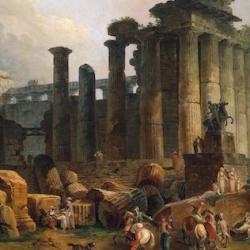In his classic work on the Common Background of Greek and Hebrew Civilizations, Cyrus Gordon points to a very specific parallel:
“Homeric tradition often represents military organisation as contingents of troops under a triad of officers for each contingent.” He cites Iliad 1.563-7 and Odyssey 14.470-1 for support. And he compares it to the list of officers in David’s army in 2 Samuel 23 and 1 Chronicles 11.
Gordon suggests that “triads in this catalogue of David’s officers are also reflected in problematic forms of the numeral ‘3,’ which may have been distorted in the course of textual transmission because the Davidic system was not fully understood by later generations.” Still, “the Homeric terminology ties in with the Biblical in some detail. Just as Cebriones and Asius . . . are called tritos, ‘third,’ officers are frequently falls shalish . . . in Hebrew. It is furthermore not unusual in both traditions to designate one officer in each triad as the chief. Much as Sarpedon is called superior to his associates . . . Abishai is honored in 2 Samuel 23:18 as ‘chief of the triad’ and as having won special fame ‘among the three’” (17).
Philistines, Gordon argues, provide the link. Philistines were an offshoot of Aegean civilization, and Philistines dominated Israel prior to the rise of the monarchy. The fact that David served Achish of Gath suggests that he might have borrowed a principle of military organization from his Philistine frenemies (17-18).
When we add the fact that the “three” are considered, along with a prince or king, as cornerstones of a political “house” that is modeled on the four-cornered cosmos, the parallel becomes even more significant. We have not only a numerical connection, but a parallel with respect to political cosmology.















